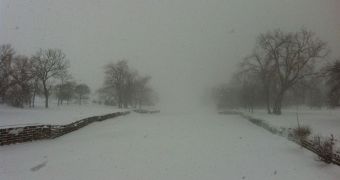As global warming starts to make its effects felt around the world, the Northern Hemisphere is bound to suffer from more severe, colder winters as a result. A study detailing this seemingly-counterintuitive connection was published in the January 12 online issue of Environmental Research Letters.
The team says that the ensemble of climatic process that underlie this link is called the Rube Goldberg-machine. Basically, it explains why summers with above-average temperatures lead directly to colder-than-normal winters in certain parts of the Northern Hemisphere.
In order to understand how this works, it's important to remember that global temperatures have been increasing since the 1880s, which is when accurate weather records began being kept. But warming accelerated over the past four decades, primarily due to increasing greenhouse gas emissions.
What is even worse is that average temperatures in the Arctic have been increasing twice as fast as the global average, since the effects of warming are more pronounced at the poles. The North Pole, in particular, is the traditional area of effect for the important Arctic Oscillation.
Though one could easily expect global warming to cause warmer winters, the fact is that temperatures are decreasing during wintertime in the southern parts of Canada, the eastern seaboard of the United States, and huge portions of northern Eurasia, ScienceNow reports.
In the new study, experts at the consulting firm Atmospheric and Environmental Research (AER), in Lexington, Massachusetts, detail the intricate connection between warmer summers and cooler winters. The group was led by climate modeler and scientist Judah Cohen.
The main culprit in this link is Arctic sea ice melt. As ice sheets collapse during the summer, more water vapors make their way into the atmosphere, moisturizing it, and increasing the amount of clouds that will manifest themselves in the autumn.
Increased cloudiness (especially in October) leads to higher snowfall and snow coverage in Siberia, and this helps strengthen the Siberian high, a semipermanent high-pressure system. The latter in turn reinforces the Arctic Oscillation.
When the AO is strong, it is more capable of driving frigid air southwards, towards areas located at mid-latitudes. These regions would have otherwise had a relatively calm winter, with moderate snowfall, temperatures and precipitations.
Oregon State University climate scientist Anne Nolin comments that this connection is entirely possible, but says that the new work does not prove cause and effect. Regardless, she adds, the study opens a new direction of research in climate science, which could help us better understand our planet.
“Northern Eurasia is the largest snow-covered landmass in the world each winter,” so it makes sense for it to have the most significant influence on the climate of the Northern Hemisphere, Nolin says.

 14 DAY TRIAL //
14 DAY TRIAL //